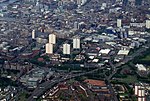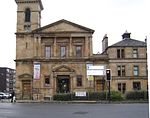Glasgow School for Business and Society
2002 establishments in ScotlandBusiness schools in ScotlandGlasgow Caledonian UniversityScotland education stubsUse British English from March 2017
The Glasgow School for Business and Society is the largest business school in Scotland. It is part of Glasgow Caledonian University, and was established in 2002, originally named the Caledonian Business School. It offers programs in business studies, law and the social sciences. Its main campus is located in Glasgow, and it has an additional campus in London (GCU London). The school is also home to the Moffat Centre, one of the world’s leading university research centres in tourism and travel.
Excerpt from the Wikipedia article Glasgow School for Business and Society (License: CC BY-SA 3.0, Authors).Glasgow School for Business and Society
Aitken Road, Glasgow Cowcaddens
Geographical coordinates (GPS) Address Nearby Places Show on map
Geographical coordinates (GPS)
| Latitude | Longitude |
|---|---|
| N 55.867129 ° | E -4.250363 ° |
Address
GCU Sir Alex Ferguson Library
Aitken Road
G4 0LU Glasgow, Cowcaddens
Scotland, United Kingdom
Open on Google Maps








